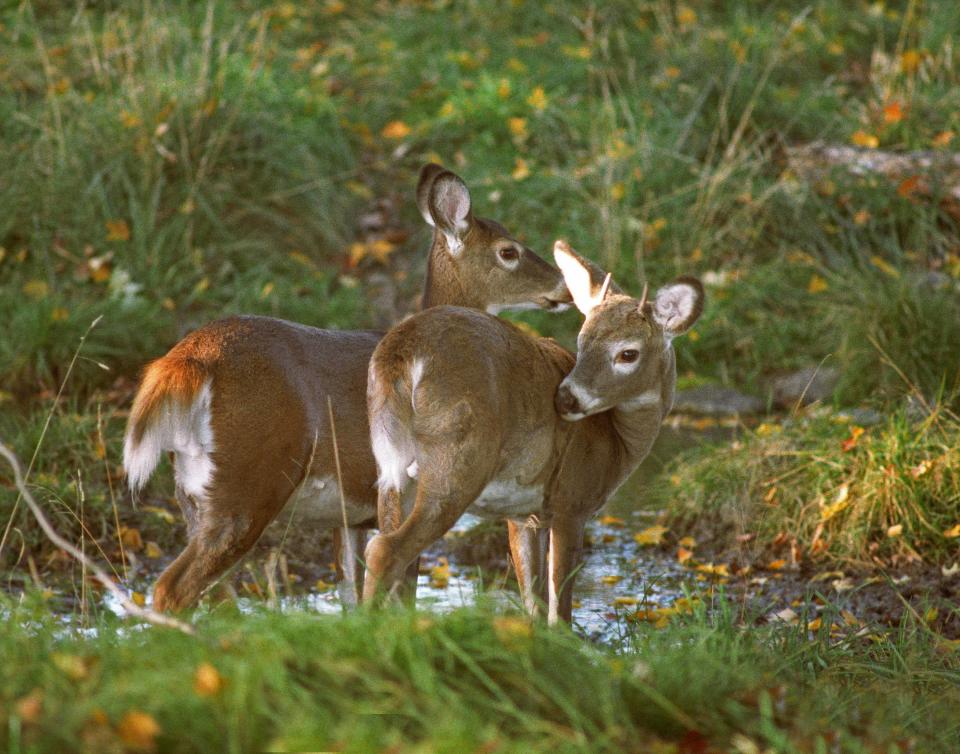Stay alert: Risk of hitting deer on Vermont highways is high with breeding season
The deer lay dead in the median of Interstate 89 north of Burlington. The car that hit it was pulled onto the shoulder, with extensive damage to the left front bumper. An ambulance was on scene.
This is a scenario that plays out thousands of times every year on Vermont's roadways, and the risk of hitting a deer is never higher than right now, according to the commissioner of the Vermont Fish and Wildlife Department.
"This time of year with the change in the season and the rut, (deer) are moving around a lot," Chris Herrick said. "It's breeding season."

Herrick has compiled the number of deer hit and killed by cars in Vermont over the last five years, and has further broken down those numbers by age and sex of the deer. Here's what he found:
In 2016, a total of 2,313 deer were hit and killed, including 483 adult males; 1,126 adult females; 310 juvenile males and 394 juvenile females.
In 2017, a total of 2,246 deer were hit and killed, including 508 adults males; 1,067 adult females; 287 juvenile males and 384 juvenile females.
In 2018, a total of 2,524 deer were hit and killed, including 534 adults males; 1,252 adults females; 319 juvenile males and 419 juvenile females.
In 2019, a total of 2,219 deer were hit and killed, including 487 adults males; 1,132 adult females; 239 juvenile males and 361 juvenile females.
In 2020, a total of 1,948 deer were hit and killed, including 410 adult males; 1,021 adult females; 219 juvenile males and 298 juvenile females.
Herrick does not yet have any data for 2021. He said the drop in numbers of deer killed in 2020 is almost certainly because people drove less during the height of the pandemic.
"It's unfortunate to see a deer die, and it also does damage to a lot of cars, but it's unfortunately part of cohabitating with wild animals in the state like we do," Herrick said.
Slow down, stay alert
Based on anecdotal evidence, Herrick said it's often the case that drivers have no chance to avoid hitting a deer.
"There are many cases where they're in front of you, and there's nothing you can do to avoid it," Herrick said. "Which is sad."
Drivers can lessen their chances of hitting a deer, however, by slowing down and staying alert.

"That's how I drive," Herrick said. "My eyes are constantly looking to the side. I've avoided crashes because I can see their eyes, and I'll slow way down."
John Hall, an information specialist with Vermont Fish and Wildlife, offers the reminder that if a deer passes safely in front of your car, there may be one or more deer behind it that will also be crossing the road.
That said, Herrick acknowledges that it can be risky to suddenly brake, especially in bad weather.
"It's a tough situation to be in," Herrick said.
One last thing. If you hit a deer and it's not killed outright, call 911.
"That's what we ask people to do if a deer needs to be dispatched," Herrick said.
Related: Vermont Fish and Wildlife Department calls on deer hunters to submit incisors for research
It's hunting season in Vermont: Brush up on these strategies to stay safe in the woods.
Contact Dan D’Ambrosio at 660-1841 or ddambrosio@freepressmedia.com. Follow him on Twitter @DanDambrosioVT. This coverage is only possible with support from our readers.
This article originally appeared on Burlington Free Press: Avoid hitting deer by staying alert and slowing down says VT official

